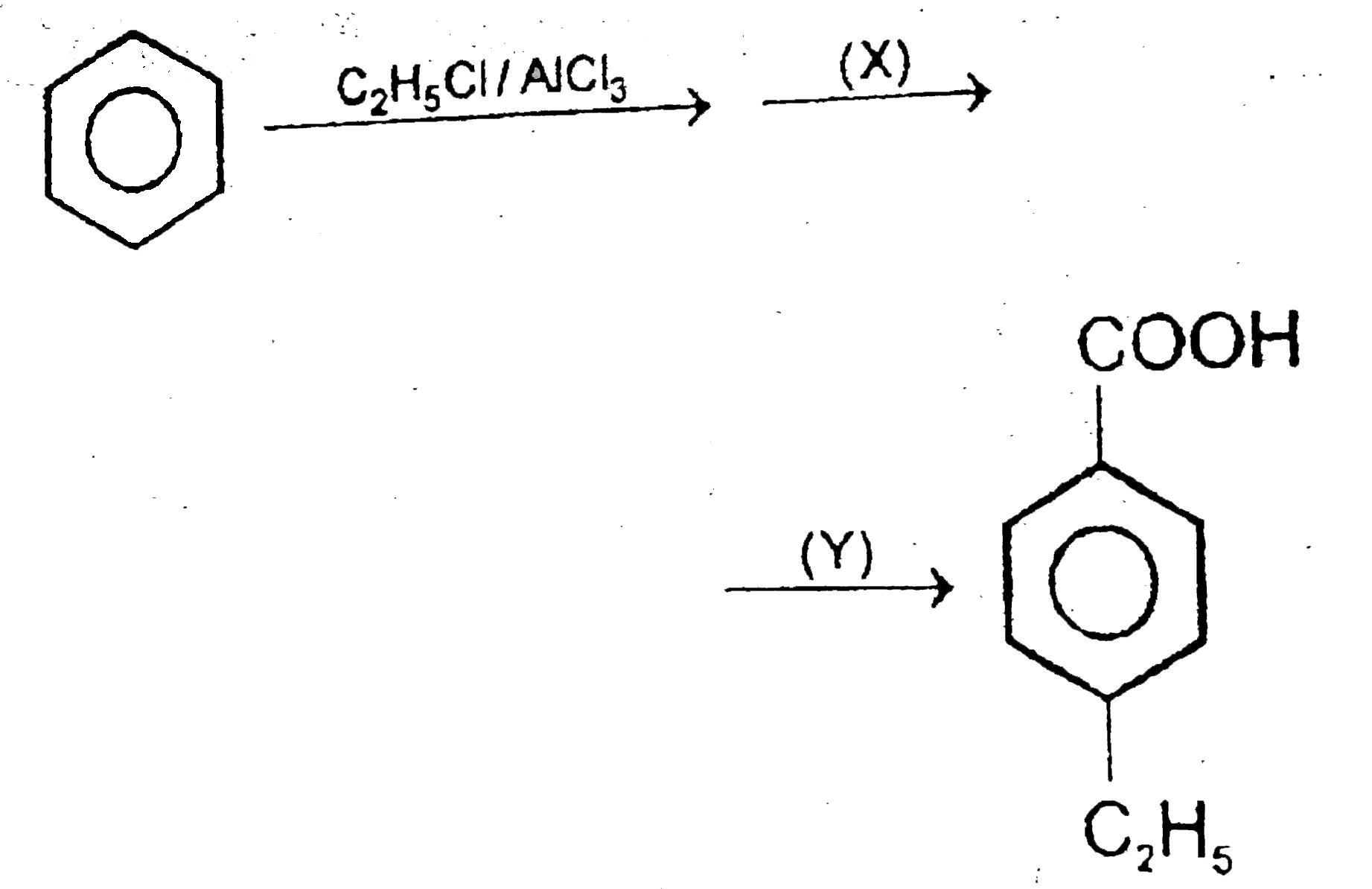When a reagent (X) reacts with Fe3+ salt solution turnsred due to the formation of a compound (Y). This reagent cause no change in colour with Fe2+ salt solution. Compound (X) and (Y) are respectively:
NH4SCNandFe(SCN)3
K4[Fe(CN)6]andFeSO4
Na2HPO4andFeSO4
K3[Fe(CN)6]andK2Fe[Fe(CN)6]
The correct Answer is:A
To solve the question, we need to identify the reagent (X) and the compound (Y) formed when reagent X reacts with Fe³⁺ ions. Here's a step-by-step breakdown of the solution:
Step 1: Understanding the Reaction
The question states that when a reagent (X) reacts with Fe³⁺ salt solution, it turns red due to the formation of compound (Y). Additionally, it mentions that this reagent does not cause any color change with Fe²⁺ salt solution.
Step 2: Identifying the Reagent (X)
A well-known reagent that reacts with Fe³⁺ ions to produce a red-colored complex is ammonium thiocyanate (NH₄SCN). When NH₄SCN is added to a solution containing Fe³⁺ ions, it forms a complex ion, which is responsible for the red color.
Step 3: Writing the Reaction
The reaction can be represented as follows:
Fe3++3NH4SCN→Fe(SCN)2++3NH+4
The complex ion formed, Fe(SCN)2+, is known for its blood-red color.
Step 4: Identifying the Compound (Y)
From the reaction, we see that the compound (Y) formed is Fe(SCN)2+, which is the blood-red colored solution mentioned in the question.
Step 5: Confirming the Behavior with Fe²⁺
The question also states that reagent (X) does not cause any color change with Fe²⁺ ions. This is consistent because ammonium thiocyanate does not react with Fe²⁺ ions in a way that produces a colored complex.
Conclusion
Based on the above analysis, we can conclude:
- Reagent (X) is Ammonium Thiocyanate (NH₄SCN)
- Compound (Y) is Iron(III) Thiocyanate (Fe(SCN)2+)
Final Answer
- Reagent (X): NH₄SCN
- Compound (Y): Fe(SCN)2+
The question states that when a reagent (X) reacts with Fe³⁺ salt solution, it turns red due to the formation of compound (Y). Additionally, it mentions that this reagent does not cause any color change with Fe²⁺ salt solution.
A well-known reagent that reacts with Fe³⁺ ions to produce a red-colored complex is ammonium thiocyanate (NH₄SCN). When NH₄SCN is added to a solution containing Fe³⁺ ions, it forms a complex ion, which is responsible for the red color.
The reaction can be represented as follows:
Fe3++3NH4SCN→Fe(SCN)2++3NH+4
The complex ion formed, Fe(SCN)2+, is known for its blood-red color.
From the reaction, we see that the compound (Y) formed is Fe(SCN)2+, which is the blood-red colored solution mentioned in the question.
The question also states that reagent (X) does not cause any color change with Fe²⁺ ions. This is consistent because ammonium thiocyanate does not react with Fe²⁺ ions in a way that produces a colored complex.
Based on the above analysis, we can conclude:
- Reagent (X) is Ammonium Thiocyanate (NH₄SCN)
- Compound (Y) is Iron(III) Thiocyanate (Fe(SCN)2+)
- Reagent (X): NH₄SCN
- Compound (Y): Fe(SCN)2+
Topper's Solved these Questions
- QUALITATIVE INORGANIC ANALYSISBOOK - VK JAISWAL ENGLISHCHAPTER - QUALITATIVE INORGANIC ANALYSISEXERCISE - LEVEL 3
62 Videos
- QUALITATIVE INORGANIC ANALYSISBOOK - VK JAISWAL ENGLISHCHAPTER - QUALITATIVE INORGANIC ANALYSISEXERCISE - ONE OR MORE ANSWER IS/ARE CORRECT
43 Videos
- QUALITATIVE INORGANIC ANALYSISBOOK - VK JAISWAL ENGLISHCHAPTER - QUALITATIVE INORGANIC ANALYSISEXERCISE - SUBJECTIVE PROBLEMS
4 Videos
- PERIODIC PROPERTIESBOOK - VK JAISWAL ENGLISHCHAPTER - PERIODIC PROPERTIESEXERCISE - MATCH THE COLUMN
11 Videos
- s-BLOCK ELEMENTSBOOK - VK JAISWAL ENGLISHCHAPTER - s-BLOCK ELEMENTSEXERCISE - SUBJECTIVE PROBLEMS
2 Videos
Similar Questions
Knowledge Check
Primary alkyl halide C4H9Br (X) reacts with alc. KOH to give compound (Y). (Y) reacts with HBr to give compound (Z) which is an isomer of (X). When (X) reacts with Na metal it gives compound (P). (X), (Y), (Z) and (P) are
A X Y Z PCH3−CH∣CH3−CH2BrCH3−C∣CH3=CH2CH3−Br∣C∣CH3−CH3C8P18B X Y Z PCH3CH2CH2CH2BrCH3CH=CHCH3CH3−CH∣Br−CH2CH3C5H10C X Y Z PCH3−CH∣Br−CH2CH3CH3CH=CHCH3CH3CH2CH2CH2BrC7H14D X Y Z PCH3−CH∣CH3−CH2BrCH3CH=CHCH3CH3−CH∣Br−CH2CH3C6H12The temporary hardness of a water sample is due to compound X. Boiling this sample converts X to compound Y. X and Y, respectively, are :
AMg(HCO3)2 and MgCO3BCa(HO3)2 and CaOCCa(HCO3)2 and Ca(OH)2DMg(HCO3)2 and Mg(OH)2
When ammonia is added to cupric salt solution, the deep blue colour is observed it is due to the formation of:
View SolutionSulphide ion reacts with [Fe(CN)5NO] to form a purple coloured compound (X). In this reaction oxidation state of iron .
View SolutionAt higher temperature sodium metal reacts with alumina to give a sodium compound 'X'.'X' is dissolved in water and then carbon dioxide gas is passed through it, a compound 'Y' is formed. The compound 'X' and 'Y' are respectively
View SolutionThe temporary hardness of a water sample is due to compound X. Boiling this sample converts X to compound Y. X and Y, respectively, are :
View Solution(i)A black coloured compound (B) is formed on passing H2S through the solution of a compound (A) in NH4OH
(ii)(B) on treatment with HCl and potassium chlorate or aquaregia gives (A)
(iii)(A) on treatment with KCN gives a buff/reddish-brown coloured precipitate which dissolves in excess of this reagent forming a compound (C).
(iv)The compound (C) is changed into a compound (D) when its aqueous solution is boiled in air.
(v)The solution of (A) was treated with excess of NaHCO3 & then with bromine water. On cooling & shaking for some time, a green colour of compound (E) is formed.No change is observed on heating.
Identify (A) to (E) and give chemical equations.
View SolutionA compound 'X', molecular formula C4H8Br2 on treatment with zinc in an alcoholic solution, forms an alkene Y. Compounds X and Y respectively are
View Solution
